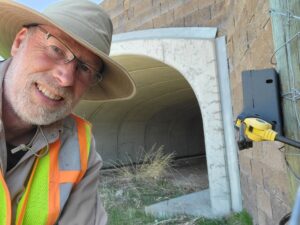
WTI’s Dr. Marcel Huijser received funds from the Yellowstone to Yukon Conservation Initiative (Y2Y) to support continued grizzly bear research along US Hwy 93 North on the Flathead Indian Reservation in Montana. Conducted in collaboration with the Confederated Salish & Kootenai Tribes (CSKT) – known as the Séliš–Ql̓ispe in the Séliš language and K̓upawiȼq̓nuk or Ksanka in the Ktunaxa and Ksanka languages – the research is focused on grizzly bear use of wildlife crossing structures. “It is important to know if the existing crossing structures are suitable for the bears, particularly sows with cubs, so that their natural movements across the landscape can be supported. If the barrier effect of highways is substantially reduced, then their genetic and demographic connectivity is preserved, and they can also strengthen or repopulate other areas further away,” said Huijser.

More wildlife fences and crossing structures are needed to reduce direct road mortality and facilitate the safe movement of grizzly bears from one side of the road to the other. Preliminary data collected by Huijser and two research collaborators, Payton Adams and Samantha Getty, suggest that while some grizzly bears use the large culverts that are the most common structures along the road, sows with cubs rarely do. They prefer very large (50-70 meters wide) crossing structures and large open span bridges. Currently, the vast majority of family groups cross the highway at road level, where they risk being hit by vehicles. Between 1998 and 2022, at least 22 grizzly bears were hit and killed along US Hwy 93 North on the Flathead Indian Reservations. Seven of them (32%) were cubs.
To reduce roadkill, the Montana Department of Transportation (MDT) is currently increasing the length of the wildlife fences along US Hwy 93 and connecting them to existing underpasses. According to a United States Fish and Wildlife Service Tribal Wildlife Grants Program-funded report written by Adams, Huijser, and Getty and published by the CSKT, this will likely reduce the number of grizzlies and other large mammal species killed by vehicles. However, unless more suitable crossing structures are provided as well, extended fences may also result in a greater barrier for grizzly bears, especially sows with cubs.
Along with larger crossing structures and fencing, the researchers recommend a full suite of mitigation measures along Hwy 93 North such as wildlife jump-outs (mounds along the fence that are intended to allow animals to leave the roadway but not enter), zero fence gaps, and electrified barriers at access roads. Combining these mitigation measures with habitat restoration, especially along riparian zones, would allow for better habitat and easier access to crossing structures for grizzly bears of all ages and sexes.
